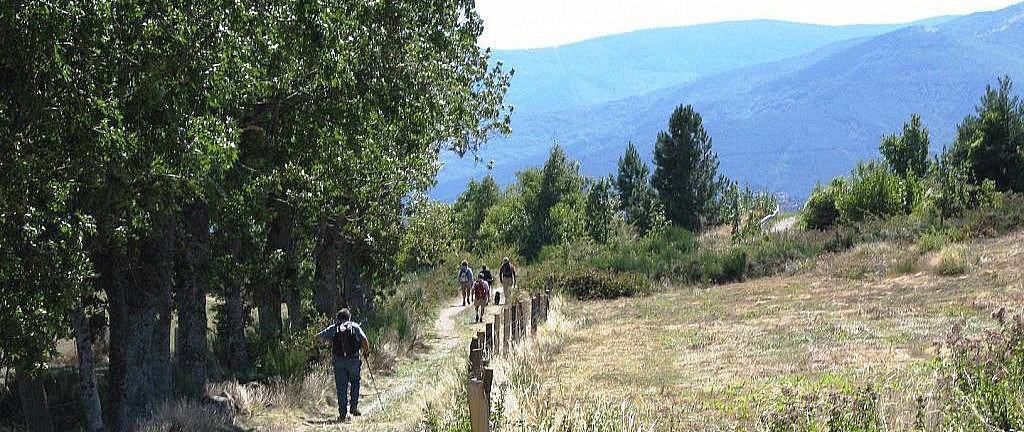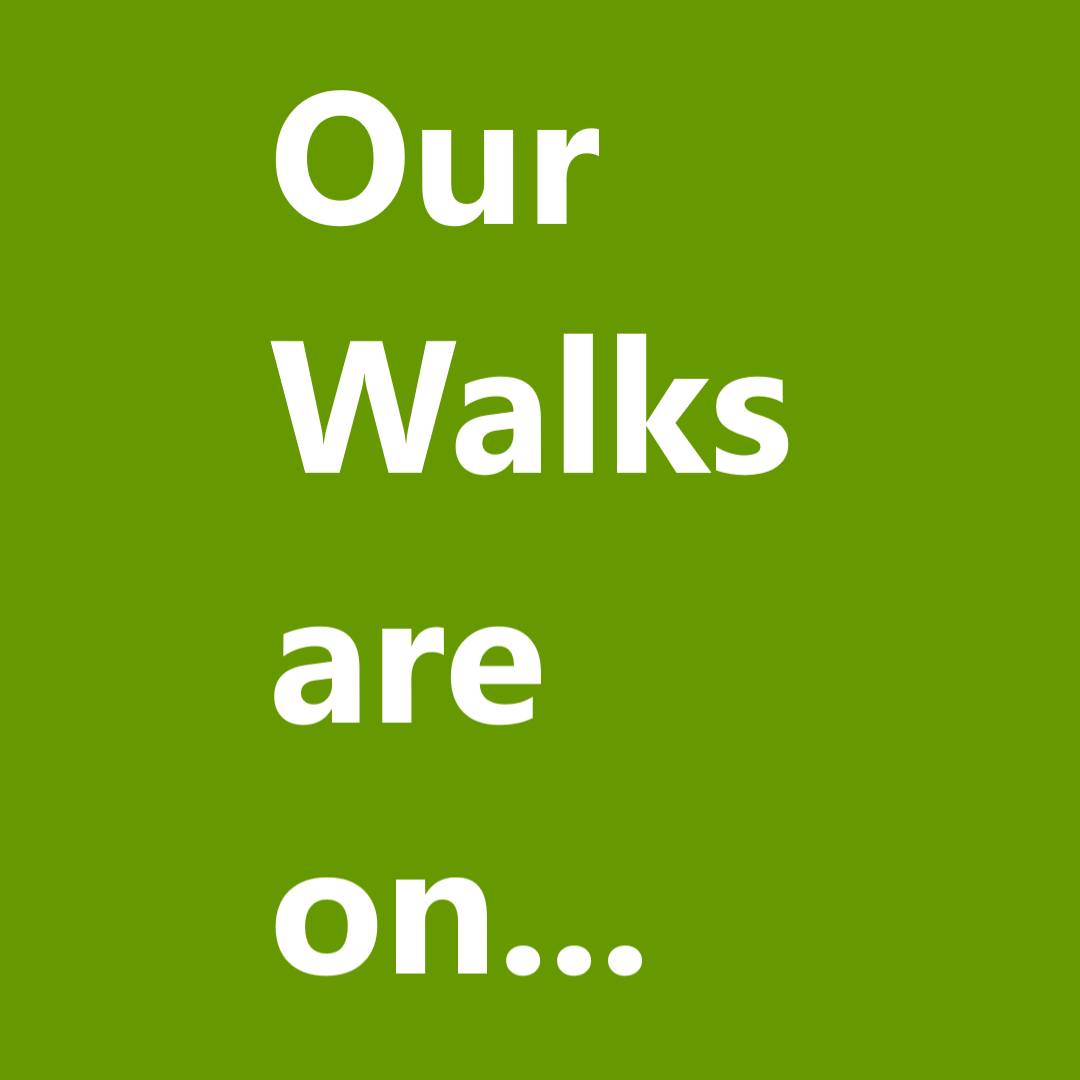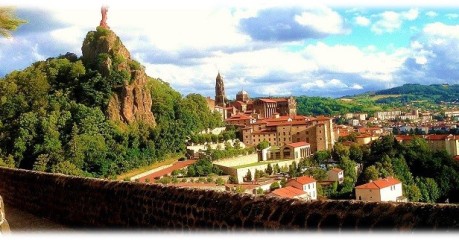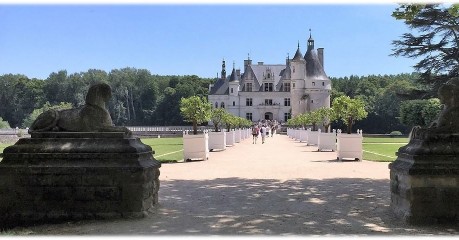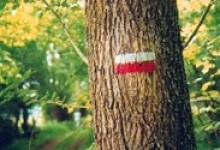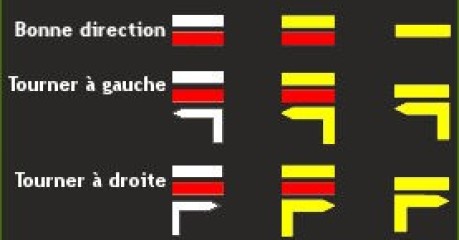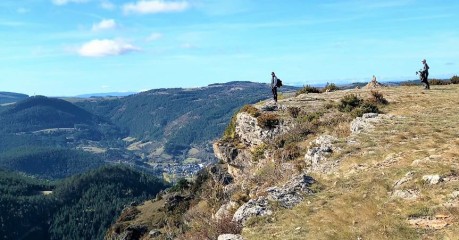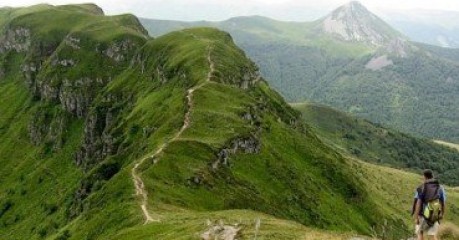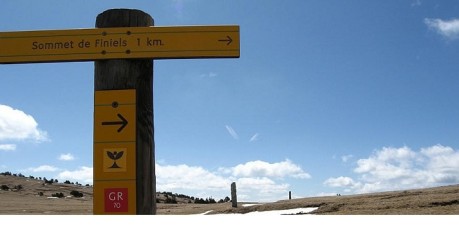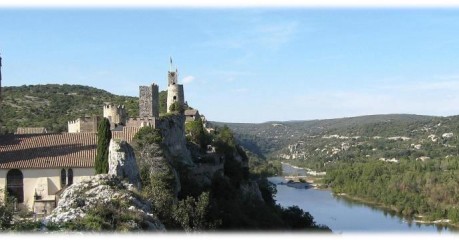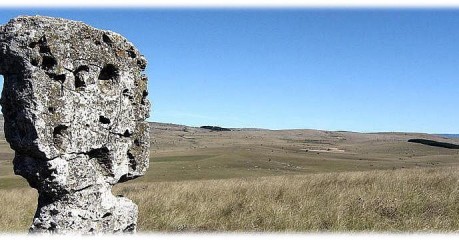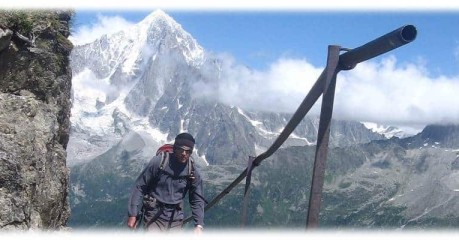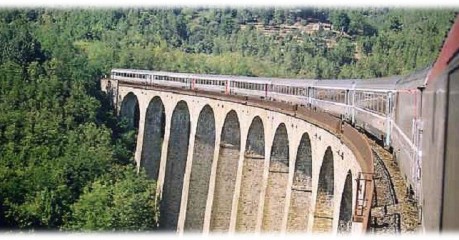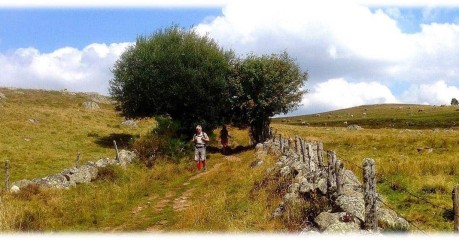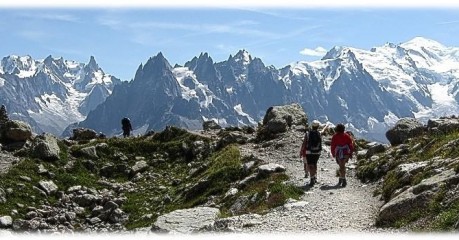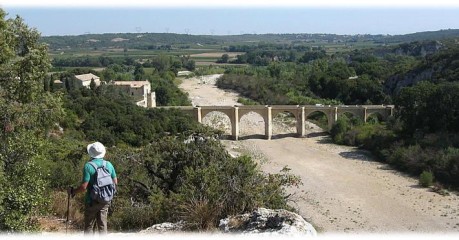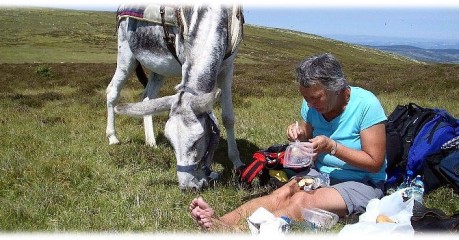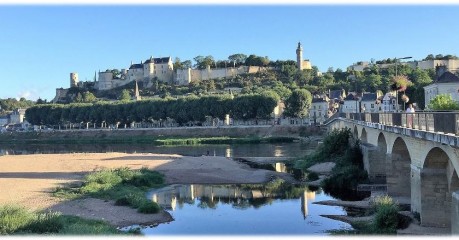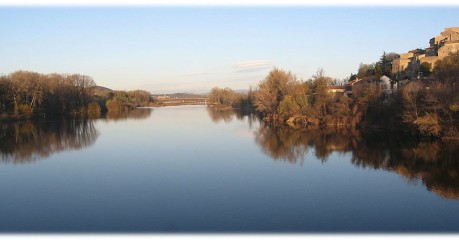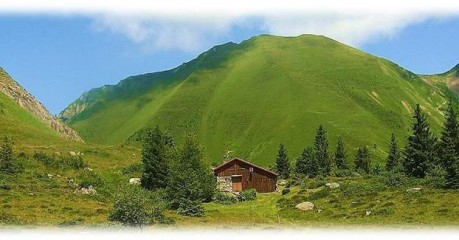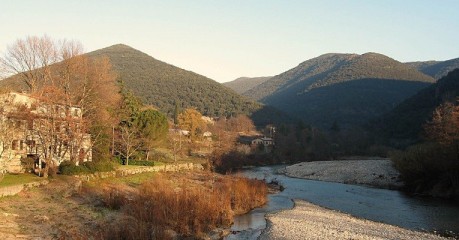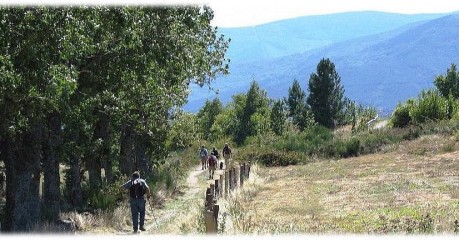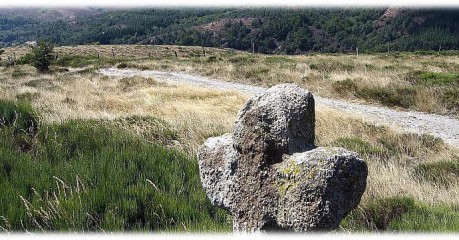Hiking in France
Hiking in France is the ultimate way to learn about the country at first hand. This comprehensive guide to hiking in France is designed to be your perfect introduction to the subject. We hope it reads like a ‘French Hiker’s Guide to discovering France.’ It will empower you, help you refine your options and plan your trip.
There is simply no substitute to arriving at a location and exploring it on foot. By way of example, let’s compare two options for visiting France’s second-most-popular national treasure and Grand Site de France, Le Pont du Gard: as a day-tripper tourist and as part of a self-guided, but organised, hiking-in-France experience.
A typical tourist queues for an hour to get into the car park only to be ‘fined’ about 25 euros for the privilege (sic) of parking there – and for how long? And the parking area is so full that you are worried about paying the insurance excess if you return it scratched.
Follow the yellow brick road into the conveniently-located and newly-built tourist
reception centre that you are about to help amortise.
Spend some cash on a trashy souvenir that you never realised you needed. Add the bill for the drinks and ice-cream at the over-priced café and you’re down by nearly a hundred bucks before you’ve seen anything! Then follow the crowd both to and from the Welcome Centre to see…
Contrast this with hiking in France and Day Six of our Gardon Gorge tour. You would have stayed for a second night in your sumptuous 4-star hotel in nearby Collias, a fine provence-style village on the banks of the Gardon River. A leisurely morning’s walk at your own pace would bring you to a belvedere over the Gardon with great views of le chateau Saint Privat.
Boasting an English and a French garden, five furnished halls and a chapel, the Castle is renowned as the place where Louis XIII signed the “Paix d’Alais” / Peace Treaty of Ales in 1629 elaborated by Cardinal de Richelieu. This allowed for equal rights between Protestantism and Catholics until Louis XIV revoked it.
After a further two kilometres along some of the most gentle paths imaginable for hiking in France, you suddenly catch sight of the famous Viaduct and approach it along a trail that most locals are not familiar with. Explore its charms via our comprehensive and insightful walking notes, that will take you to vantage points over the Roman viaduct that will have you catching your breath.
Once your phone is suffering from memory loss, you continue along your trail, following the remains of the viaduct that carried water from nearby Uzes to Roman Nimes – and having successfully given the Tourist Centre a wide berth. That, mes chers amis, is just one example of the myriad advantages of walking in France.
Hiking in France offers you an embarrassment of choices to escape the crowds and get off the beaten track. You can choose hikes in France on long-distance routes known as Grand Randonnées or GRs. Alternatively, you can select from regional trails or local hiking paths. We show you where to go and how to ‘get remote’ and more information on these options can be found below.
If your penchant is for gentle hikes with fine cuisine, then the Mediterranean lowlands, Provence or the Loire Valley are hard to beat. We are all different: some like the challenge of moving on each day, whilst others prefer to spend a couple of nights in one location. Our trips cover both these options and you can always personalise a trip by adding extra nights in a certain location.
Whatever your preferences, plan in the knowledge that you are travelling with a family firm that is focussed one hundred percent on France. Our raison d’etre is to be the reference on hiking in France. We of course transfer your luggage from hotel to hotel and are available to help you everyday of the week from 8 ’til late.
- Background information on hiking in France
- Communication & Language
- Help with choosing your French hiking tour
- Best practice and good advice, including trip preparation, the relevant French law and
- Why you can rely on us, The Enlightened Traveller, when selecting your hiking in France partner.
There are twenty million self-confessed hikers in France and that’s one-third of the population. Where do they go hiking? In France, bien sûr! When it comes to hiking, France has it all: 120,000 miles (180,000 kms) of marked trail, much of it maintained by retired ‘volunteers’ and spanning the entire country. Your biggest challenge, then, is not deciding whether to go walking in France, but precisely where to go walking.
Background Information on hiking in France
Hiking in France is different – so Vive La Difference! In this section, we discuss what you can expect to experience when enjoying a self-guided walking tour. We consider customs and habits and focus in particular on Orientation and the French waymarking system, French hikers, greetings and trail dangers.
Orientation and the French waymarking system
Hiking trails in France are way-marked via horizontal lines on trees, lamp posts, street corners or rocks on the ground as per the photo right. The red and white way-marks represent linear, long-distance trails. The French call them ‘Sentiers de Grande Randonnées/GRs.’ They are routes of national standing that traverse more than one historic region. One of the most famous is the GR65 or Via Podiensis, which takes you from Le Puy en Velay to Conques and onwards to Santiago de Compostella in Spain.
At the regional level, we find trails known as ‘Grand Randonnées de Pays/GRPs.’ Marked in red and yellow, these trails connect themes of significant regional importance. They are often ‘circular’ in nature and designed to be explored over a period of around one week. An example here would be the GRP tour des Monts d’Aubrac.
Finally here, when hiking in France on a local level, you are likely to do so via‘Petites Randonnées/PRs’. They link together historic villages or maybe lead to a site of particular renown. Normally circular in nature, they are designed to return you to your original point of departure in a few hours. While they are customarily way-marked in yellow, some local anomalies exist. In Lozere, for example, the tradition is to way-mark PRs in green. However, don’t worry – our hiking notes will inform you of such nuances before you set out on your day’s hiking.
France is blessed with hundreds of GR pathways and each one is numbered. For example, you might see a sign saying ‘GR44’ or even ‘GR44D’. Generally speaking, both are variants of the more important GR4. In the same way, the GR70 (Stevenson Trail) and the GR700 (The St Giles Way), are considered variants of the original GR7 (trans-Cevennes trail) by the French Hiking Association, the Federation Française de la Randonée Pedestre/FFRP.
GRs are significant trails and the smaller their number, the older they are. The good news is that they are generally well way-marked. However, France has so many such routes that a particular stretch of trail can often be home to two or even three different GRs, where they intersect. This can be confusing because each way-mark is not numbered. Let our comprehensive walking notes be your guide!
You may find yourself walking a mix of GRs, GRPs and PRs all on the same day. Our leading-edge hiking notes keep you informed as to which to follow at any one moment. If we don’t tell you to change direction, don’t; and if you feel you have made a mistake, it is always better to go back to the previous junction rather than risk digging yourself deeper into a hole by continuing further along a wrong trail.
Finally here, let’s take a look at the markings in context and see what they mean as per the French schema on the left of the page. Please click on the image to reveal the full details. This should also assist you in familiarising yourself with some important basic French, whilst ensuring you avoid ‘la mauvaise direction.’
We are French-qualified, middle-mountain guides. Our training demonstrated that GPS readings can be unreliable, especially in inclement weather. We have been sent occasional GPS readings for our trails from customers – they are all different! If you feel uncertain as to your precise location at any one moment, a GPS is a useful means to reassure you, but NOT a substitute for traditional navigation methods whilst on route.
Furthermore, batteries run out and mobile coverage can be intermittent: what then? It is far better to rely on our industry-leading walking notes backed up by basic map-reading skills.
While GPS-based measurement might be more accurate in terms of exact distance walked and elevation gain/loss, it would not match up with the ‘traditional’ signage and distances you encounter on the ground, which are not GPS based. This would result in confusion.
Hiking trails can be broken down into different stages, which might not correspond to those walked by the person in that App. you downloaded. This is often the case with trips like the Tour du Mont Blanc/ TMB, where many hikers use ‘off piste’ and remote refuge accommodation rather than the comfortable hotels we use. They also use variants that are not part of the official TMB and that are considered dangerous in inclement weather.
Hiking is France’s main past-time. The upkeep of trails is carried out by volunteers – mainly early-retired public sector workers. Every GR in France undergoes small annual modifications, especially where overwalking occurs. Following our notes is guaranteed to get you there, but not necessarily by this year’s path!
Finally, the French IGN maps we supply are covered by copyright. Individuals may be able to download such maps and use them for personal use via GPS, but a company doing so for financial gain would be sued in court for breaking copyright. One can buy a licence of course to be able to use them, but they are very expensive and would increase costs and tour prices considerably.
French hikers
French hikers tend to be very chatty and sociable. They will be intrigued by your presence and delighted you have chosen to hike in France. They will most likely be critical of their own country and its political class, especially if they work for the Private Sector. We suggest you politely remind them of what makes France great and them so privileged!
French hikers generally get much closer to nature than you do. They hike several times a year and so budgets are more restricted. They are happy to sleep in communal refuges and dormitories, sometimes without sheets and normally without en-suite WC or shower. Quite basic facilities, then, that you would consider as ‘roughing it.’
So if you have walked with them during the day, don’t assume they’ll be staying in your comfortable hotel. Moreover, when they sing the praises of where they spent last night, put their comments into context: they average five or six trails ‘on the cheap’ each year compared with your one or two in comfort. It is that simple. Were they to hike in your back yard, they would likely trade up for that special occasion.
If you meet up with French hikers at lunch-time when hiking in France, don’t be surprised, nor take offence, if they enjoy a little nap after they’ve eaten. Don’t feel obliged to hang around and wait for them either, because the chances are they’ll catch you up later!
Hiking in France is a safe pursuit. France has its own fair share of urban social problems and unemployment is relatively high. However, trail dangers are few and far between. You have more chance of being struck by lightning than of being mugged! Accidents are quite rare and tend to be associated with alcohol, bravado or infantile behavior resulting from group dynamics. This is one of the main reasons why The Enlightened Traveller does not provide open-enrollment or guided group-walking tours.
Greetings
You are not obliged to kiss fellow hikers, nor your hotelier, so stick to a good old-fashioned handshake. The French realize that other cultures don’t necessarily ‘faire la bise.’
However, if you decide to exchange kisses, probably upon departure, make sure you know how many kisses are customary in your region – one, two, three or four!
One is rare, two is most common (both cheeks), three for Le Midi (bar Toulouse) and four for Paris. Well, like any capital city, they claim more of the cultural capital as well!
And don’t discriminate and kiss just those whom you like. As an enlightened traveler, you are far too balanced to do that. Either kiss them all or none at all! If hikers approach you from ahead, they’ll just say ‘Bonjour’ as they pass you. Those appearing from behind are much more likely to join you for a chat and accompany you for a while.
By the way, if you see a backpack in the middle of a trail, the chances are that someone is having a wee-wee (pee-pee in France, not Oui Oui!) in the undergrowth nearby. If you find ‘his and hers’ backpacks on the trail, your guess is as good as ours!
Trail dangers when hiking in France
However isolated your trail, the chances of meeting a dangerous wild animal are remote indeed. Poisonous snakes [adders, vipers] are very rare and mainly associated with watercourses; wolves, whilst slightly on the increase in upland areas, are never seen in daylight; and wild bears, whilst only recently re-introduced into the Pyrenees, are very few in number.
There are no predators that will stalk you and the only real threat is wild boar. Their numbers are certainly on the increase. However, you are much more likely to meet a dead one, killed by the local orange-capped hunting fraternity. They tend to be noisy creatures anyway, so their rummaging and snorting will generally alert you to their presence. Keep to the main trail, don’t go mushroom picking and you’ll be fine. We have never heard of a case of a hiker being charged by a wild boar, but if you see some cubs, we suggest you give them a wide berth.
If you see a line of caterpillars or ‘chenilles’ snaking across the trail in joined-up fashion, please don’t touch them because they can give you a very nasty rash!
Finally here, if you are in any way concerned about safety whilst hiking in France (particularly if walking alone) don’t hesitate to go into a cutlery or knife store before hiking in France and purchase a ‘bombe defense’ or pepper spray. These are perfectly legal to possess and can make you feel more at ease. We have considered issuing them automatically to anyone hiking on their own with us, but felt this might be a bit alarmist. The choice is yours!
Communication & Language when hiking in France.
Communicating with your hosts
Hiking in France does not require a foreign language crash course, so don’t waste money on 30-day communication solutions [sic]. With mutual effort and goodwill on both sides, people get on and get by. And, after all, exploring the boundaries of the unknown is half the fun, isn’t it?
You are provided with all the information you need to have a successful hiking trip. Our suppliers/your hosts are familiar with your requirements and the rest is up to you. Hoteliers are very busy and you are likely to be tired on arrival. Welcomes generally comprise the exchange of simple niceties. Don’t misinterpret their rudimentary language skills as lack of effort or interest in you.
If you particularly want to practise your French, and chat to both hosts and hikers, opt for tours majoring on chambres d’hotes (guest houses) and auberges (country inns) rather than hotels. We will do our best to oblige subject to availability.
Communicating with overseas family & friends
Hotels in major towns, cities and sizeable villages will have free internet access available to their customers – either in room or in the reception area. However, when on remote trails, it’s better to assume that such facilities are not available because then you will not be disappointed.
Hiking in France with a laptop computer in your luggage is certainly not advisable and done at your own risk. If you have a tablet, carry it with you in your back-pack. No-one in charge of luggage transfers will take any responsibility for such items going missing. Make sure your insurance covers such items and that your suitcase is lockable.
Furthermore, at a small supplement, our partners can ensure that extra luggage is safely stored for the duration of your trip and delivered to your final hotel in time for your departure. Please ask us for further details.
Believe it or not, the provision of internet services, like any other service in French villages, is down to the Mayor. So just as s/he may refuse piped gas into homes for fear of explosions, access to 4G internet connections may not have been given the go ahead.
We suggest you prioritise communication by SMS, or mobile text messaging, as your main means of contact with the outside world. We do not recommend the use of any ‘heavy duty’ roaming services on your phone. The level of telecoms competition is low and fees can be high – so don’t go downloading any full-length feature films for après-bar consumption!
As for snail mail, La Poste is the butt of many a French joke. The most successful French film of all time, Danny Boon’s “Chez les Schtis,” (released in 2008) piled further derision on this national institution. Unless you really have nothing better to do than queue for half a day, buy stamps where possible from newsagents (Tabac-Presse). Post your postcards using the little yellow metallic boxes on village walls, or from the airport or railway station of your choice. Or ask your hosts to oblige – they will be delighted to post it along with their own mail!
That said, there are steps afoot to automate some post offices in busy towns. In these recent developments, staff stand around and point you in the direction of a machine rather than sit behind glass windows. Progress for some, but woe betide if the machines malfunction. Cue the gallic shrug!
Communicating with The Enlightened Traveller
When hiking in France with us, do so in the knowledge that we are ‘on call’ to help you at all times. Everything you need to empower you is awaiting your arrival at the reception desk of your first hotel. If you have any concerns, however small they may be, please contact us immediately by mobile or the hotel switchboard. And we suggest you call or SMS because emails can be very unreliable! Unless we hear from you, we can only assume everything is going well. Moreover, if you don’t tell us, we cannot help resolve the matter in question.
You might wish to explore the option of purchasing a sim card in in France just in case – or even better [and cheaper] from the UK if you are British or travelling to the UK before arriving in France.
Mobile phones may not have complete coverage in countryside locations, but signals will come and go within short distances. Emergency coverage is almost universal.
Food, Travel & Weather when on a French hiking holiday.
Food
When hiking in France with The Enlightened Traveller, your meal options are generally either half-board [HB, or breakfast and dinner] or bed and breakfast [B&B]. We will occasionally include a picnic lunch if there are no reliable options available for you to shop for yourself.
i) Bed and breakfast – B&B
For us, B&B does not mean a guest house! A B&B option is likely to be offered where evening meal choices abound. You are then free to choose your evening meal according to your own personal budget and taste. This option may also appeal to vegans and vegetarians.
Whilst we ensure that any dietary requirements are brought to the attention of your hosts when making your reservation, it is your responsibility to remind them upon arrival. Hosts may not have a system for storing and recalling such matters, so the onus is on you to bring it to their attention when ordering the evening meal. Your French hosts have improved considerably over the last few years with regard to the provision of vegetarian food options on menus – thanks largely to our efforts in bringing the issue to their attention. However, fruitarians need not apply!
ii) What you will eat
You are hiking in France and the French are generally renowned for their love of food. Your hosts will showcase local fare [produits du terroirs] according to what is in season. If your are on half-board, the evening meal in hotels follows a set menu format with options. This normally comprises a meat, fish and veggie main course, with entree and dessert. If staying in an auberge or chambres d’hotes [which then becomes ‘tables d’hotes’ when evening meals are available], it is part of the convivial nature that walkers partake of the same dish around a common table. However, vegetarians will enjoy a separate offering.
If included or requested, your packed lunch will normally be fulsome and nourishing. You may find it hard to fit it all in your back-pack! As for breakfast, this can take the form of a light continental breakfast [mainly in towns] or a buffet with meat, cheese, yoghurts and plenty of strong coffee.
iii) When you can expect to eat
Finally here, if you are hiking in urban contexts, evening meals are likely to be served around 20.00 hrs. In contrast, country-side locations tend to serve meals earlier, at around 19.30 hrs.
When hiking in France, then, you need to aim to arrive at your accommodations by 19.00 hrs or alarm bells will start to ring. This may result in your hosts contacting the relevant authorities and expensive search and rescue services launched. To avoid this, either contact your hosts or us direct by phone or sms if you anticipate arriving late. Finally here, breakfast is generally served a little later in the countryside than in towns at, say, 08.00 hrs.
Travel & Getting around
We are not experts on your international travel options. Moreover, you are in the best position to explore cheaper deals available in your own country. However, we are knowledgeable on the best means of access to, and departure from, our own tour starting and finishing points. Please do not hesitate to ask for our advice and help in this respect.
Public transport is generally of a very high standard in France. We positively encourage the use of local trains and buses, and support the work of local taxi and transport firms.
The Weather
It is trite and untrue to say the weather is always great in France – it is not. When it rains, it probably pours! However, The south-eastern quadrant of The Hexagon does get better weather than the rest of the country. This is why we mainly focus on hiking in that part of southern France – with the notable exception of the Loire Valley. See Météo-France for full details.
Many customers on ten-day hikes do not feel a single drop of rain. The effects of global warming have certainly reduced precipitation levels and the traditional rainy seasons are now less predictable. Nevertheless, many people will generally experience some precipitation, however short-lived, during their trip. Whether seasoned hiker or occasional hill-walker, come prepared for both wind and rain and you will not get caught out.
The wind is the hiker’s friend, as it chases away the rain clouds and provides long periods of glorious sunshine. But it does so at a cost. The wind can blow quite strongly and the wind-chill factor is quite noteworthy. Do bring suitable clothing to combat its effects.
Finally here, make sure you bring a suitable warm pullover or fleece for those fresh early mornings and late evenings. Woe betide the t-shirt clad trekker who fails to dress accordingly once that sun goes down!
Choosing your hiking tour in France.
When looking at options for hiking in France, there are some key questions you need to ask yourself…
1. Aims & Objectives
What’s your goal? Some wish to escape to the remote French countryside and enjoy challenging full-day hiking that pushes them to the limit. Others seek short daily strolls of around 6 miles/10 kilometres in more inhabited areas, lowland.
It is essential to establish what kind of walking tour you want at the very beginning in order to avoid disappointment. As a responsible hiking tour operator, The Enlightened Traveller has established very high standards and expects to meet them. We also set out to exceed your expectations, not just satisfy them. However, we are unable to look into your mind and learn about you unless you share your interests with us.
If your hiking tour is unsuitable for you, for whatever reasons, both of us will be unhappy. And whatever we do to try to compensate for your inappropriate choice, ultimately it will be a palliative, not a cure. So, please do your research, ask questions and seek our advice before you make your tour choice.
2. Challenge or Holiday/Vacation?
- How strenuous do you want the walking to be?
- What distances do you want to walk each day?
- What ascents/descents are you comfortable with?
- Are you [or will you be] fit enough to do this particular walk?
We would suggest you consult our Classification System here and choose according to our tripartite taxonomy: Light, Moderate or Harder [quite challenging].
Remember – you are asking your body to do something it doesn’t get asked to do that often. Namely, walk on three or more consecutive days, rain, wind, shine or pain. You are likely to need some form of pre-trip exercise or training in order to get up to speed. However, some adopt the mind-set that they are capable of getting fit by just doing it – something which may become more difficult to do with age.
If you are still not sure, opt for the short break rather than the full-length trip.
3. Companionship or Splendid Isolation
Ask yourself whether you want to walk alone, with family, friends or maybe even colleagues?
As an independent hiker, you quite rightly have your own agenda. This is why The Enlightened Traveller chooses not to offer ‘open-enrollment’ group tours. Instead, we opt to satisfy the particular requirements of you and your own ‘closed’ group. And if you wish to interact casually with other hikers along the trail, ask us which trails are the best for such camaraderie.
4. Location, Time available & Theme
- Where do you want to walk – city (urban), sub-urban, coast, countryside or middle-mountain? We do not offer urban or sub-urban walking tours.
- Are you looking for a full-length or a short, 4-night walking tour? Our comprehensive tour listing can be found under Self-guided Walking Tours in France, whilst click here for short walks in France.
- What sort of themes do you like exploring? These are best discovered via our Blog: France self-guided walking trips, trails, themes.
5. Transport issues – single-centre, multi-centre or inn-to-inn.
- How do you wish to get around between hotels and walks?
- Do you want to sleep in one place, a different place each night, or somewhere between these two options?
Inn-to-inn tours necessitate a change of accommodation each night and walking normally fills the best part of the day. You hike between hotels on a linear route, whilst we look after your luggage transfers.
You might also like to consider our ‘multi-centre’ walks in France which offer a mix of straight-line and circular walking. This avoids changing accommodation every day. Furthermore, morning and end-of-afternoon transfers are often used to get you into position or back to base. Luggage transfers still form part of the package and the circular walks generally offer options to suit your needs on the day.
We do not offer pure ‘single centre’ tours as you do not really require our input if you just wish to hire a gite and walk around its hinterland. Moreover, if you know of one location with four or five great days’ walking around it, we would love to hear where it is!”
Finally, you may also like the idea of our eco-friendly tours by rail, which are ‘circular walks’ linked together by rail travel. You can learn more about this here.
Of course, all of the above options are available as either full-length or short hiking tours.
6. What’s included and Accommodation-type.
Our hiking tours always include breakfast but not necessarily evening meals. It’s a question of getting the balance right between customer choice and convenience. Our rule of thumb is as follows: if you’ve been walking all day, you are unlikely to want to explore meal options upon arrival. Inn-to-inn treks thus include dinner. However, where walking is of a more leisurely nature, with more time to ‘look around’ and with choices on offer, we let you decide what and where to eat.
Nevertheless, the best accommodation options in certain locations may simply lend themselves better to a bed and breakfast option. This is based on our local knowledge, of course. Details of restaurants are to be found in your tour dossier. The walking notes will tell you where you can purchase the contents of a packed lunch or pannier pique-nique. We may include one or two where it’s more convenient to do so. Most hosts can, of course, provide packed lunches on demand, so long as you ask them upon arrival – not just before departure!
Finally here, let’s consider accommodation itself. Do you have a preference for the camaraderie or warmth of the auberge or chambres d’hotes experience? Or is your ideal end of the day the glorious isolation of a hotel? The answer may depend in large part on your French language proficiency.
You’ll also be keen to consider the insight we provide on the general accommodation scene in France here.
Fitness & Physical Preparation prior to commencing your hiking tour.
Be aware of the question of your fitness level or capacity. Would you describe yourself as a ‘promeneur’ (casual stroller), ‘marcheur’ (walker/rambler), ‘randonneur’ (hiker) or ‘montagnard’ (experienced, middle-mountain trekker)? Ask yourself how well you are prepared physically to walk for several days. Is your fitness level sufficient to make it an enjoyable experience or will you struggle? Some form of pre-tour training is highly recommended.
You can enjoy light hiking in France provided you have no physical ailments. In fact, many unfit people regain fitness and good health through enjoying an appropriate walking holiday. However, if you intend to take your hiking more seriously, and move onto more challenging walks, it is important to increase your fitness levels gradually and set yourself achievable targets. Over-exertion can lead to exhaustion and increases the chances of injury and non-completion.
Some consider that the best way to ‘prepare’ the body for the rigours of a hiking tour is to simply go there and do it. We prefer a strategy that sees you building up hiking-specific power in the legs, strength in the cardio-vascular system and endurance and stamina.
There are plenty of methods to gain physical fitness and here are just a few you might like to consider: running, using an inclined treadmill, stairs with a pack, cycling and swimming. The above ‘primary exercises’ should be done, say, four times a week during the working week, to which one should add a day or two of secondary exercise at weekends. These activities should include…
- 1) Day hiking – rain or shine, get out for a good, solid day-hike with elevation gain if possible. After a month or so of primary exercise, you may find that previously difficult day hikes become only moderate challenges.
- 2) Long-weekends of hiking – go on two or three day backpacking trips to toughen the body, learn to use your gear, and spend lengthy periods in the countryside.
- 3) Snowshoeing. In the winter time, when snow covers the ground, you can find a whole new world to play in. Trails that you would not wish to walk in the summer time become stunningly beautiful in winter. However, beware of hypothermia.
- 4) Orienteering – get a good map, plan an itinerary, and take a compass to navigate your way (usually mostly off trail) to a certain destination. On a competitive level, try to do this as quickly as possible.
Planning & Research.
It may sound obvious to many, but planning and researching your hiking trip really makes all the difference. Our hiking dossier will include lots of interesting information gleaned from a multitude of sources. However, it is not necessarily comprehensive and aims to whet your appetite and stimulate further learning – hopefully both before and after your tour. We thus strongly recommend you do your own research in order to supplement our dossier.
Guide books go out of date very quickly and even the most famous of trails undergo frequent changes. None of them include full-size Institut Géographique National/ IGN) maps, so most settle for 1/50000 scale.
Be aware that footpaths marked in red on these maps (Grande Randonnees/GRs, Grande Randonnees du Pays/GRPs or Petites Randonnees/PRs) may be somewhat overgrown or lack fresh way-markings. This largely comes down to the popularity of the trail in question. However, basic map-reading skills and a compass and the wherewithal to use it will be richly rewarded. And make sure you have the most recent version of the map and bear in mind that these are only re-printed about every seven years.
Ten reasons why you can rely on us when hiking in France.
The Enlightened Traveller Company Charter.
- 1. Accessible. We are available to you seven days a week, all year round. You benefit from this ‘open door’ approach. You will most likely do your research at the weekends when we are open and available to assist your planning. Once in situ and enjoying your hikes, we are here and ready to help if you need us. There is no 9 ’til 5 culture at The Enlightened Traveller. Tomorrow morning is often too late and problems rarely occur at convenient times of the walking week.
- 2. Anglo-French status. We thus straddle both sides of the Channel/La Manche and speak both languages fluently. We understand your needs as regards hiking in France and know how to get the best out of our French partners – accommodation providers, taxis firms, luggage transport companies and so on. You benefit from the mutually-beneficial partnership we have forged with our French suppliers and from our unique Anglo-French status.
Remember: The Enlightened Traveller – delighting mind, body and sole!
Further Reading
- Choose your tour according to the level of challenge: Light walks in France, Moderate walks in France or Harder walks in France..
- Opt for one of our short walks in France
- Click to visit The French Hiker’s Guide to Holidaying in the Hexagon and the France self-guided trips, trails, themes…
